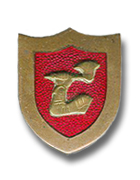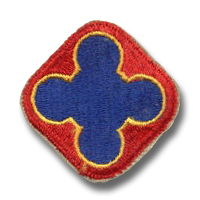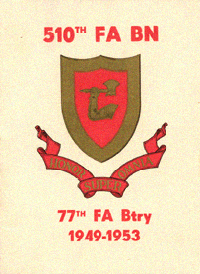If you do
NOT see the Table of Contents frame to the left of this page, then
Click here to open 'USArmyGermany'
frameset |
510th Field Artillery Battalion
Tactical Command
Looking for more information from military/civilian
personnel assigned to or associated with the U.S. Army
in Germany from 1945 to 1989. If you have any
stories or thoughts on the subject, please contact me . .
|
|
|
|
|
|
| 510th FA Battalion
History |
|
| 1953 |
 510th FA Bn DI 510th FA Bn DI |
| |
| (Source: Unit History "510th FA BN & 77th FA Btry, 1949-1953") |
|
|
This unit history was originally compiled and edited by 1st Lt. Nelson L. Thompson, Arty, and 2nd Lt. Jack E. Carter, Arty. It was published by Etzendorfer & Co in Salzburg, Austria. The booklet leads off with a brief WWII history of the 975th Field Artillery Battalion (predecessor to the 510th) and the 634th Field Artillery Battalion (predecessor to the 77th).
On 1 February 1949 the 510th Field Artillery Battalion was activated and assigned to the United States Forces in Austria. Attached to the 510th FA Bn at the same time was the 77th Field Artillery Battery. The officers and men for both organizations came from the 24th Constabulary Squadron which had just been deactivated at Camp McCauley, near Linz, Austria.
We now pick up their history in 1949... |
|
| |
On the first of February, 1949, under the command of Lt. Col. John R. Magnusson, the 510th Battalion and the 77th Battery were incorporated into a single artillery unit, charged with the responsibility of supplying the artillery support for the combat forces of Austria.
The early days were hectic and confusing as we trained ourselves into the brand new duties of cannoneers. In June of 1949 the 510th, and with it as always, the 77th, went into the field for our first 4 day problem, and ironed out the fundamentals of communication, displacement and operation in the field.
By mid-August training had progressed sufficiently to warrant an entire month of firing and action in Obermieming, located in the French Zone of Austria. There we learned the pieces weren't loaded by stomping the round down the muzzle and found out the noise made in firing wasn't quite fatal. In September we rolled out of the Alps down to Saalfelden and concentrated on the various small arms. It was while undergoing this training that our first commanding officer, Lt. Col. Magnusson, was replaced by a new CO, Lt. Col. Royal E. McShea.
In the first week of October we packed away our now familiar equipment and headed home - Camp McCauley. With only two days to collect ourselves we again took to the field for an 8 day series of battles over the Ried area with "C" Battery joining the Aggressor forces.
In the Fall of 1949 we settled into garrison duty. "A" Battery took up the border patrol along the Danube River at Enns and Steyr, Austria, and the ranks of the battalion swelled with new officers and men.
Mid-December found us transferring bag and baggage to Camp Truscott, Salzburg, on the "rotation" program, and according to well informed sources, we took over Salzburg with the same confidence and purpose that we took over our new billets. The winter experience in this reputedly quiet old city will linger in the memories of many people a long time. While at Camp Truscott a system of unit level competition was instituted for the battery with the "Best Motors", "Best Conduct", "Best Billets" and "Best Mess" each month. From their inception these plaques have instigated violent sessions of competition, indignation and pride.
Field duty never went neglected in the 510th, as we had a field problem in January, another following the1st Anniversary celebration and still another on our way home to McCauley. In March 1950 we participated in a 9 day maneuver in the Vocklabruck-Ernsting area, had another 3 day problem and hit the trail for our first visit to one of the oldest artillery ranges in Europe at Grafenwohr, Germany. Here on ground which once reverberated from Napoleon's cannon fire we settled into our role as artillerymen and learned the trade well, firing for six weeks before returning to Austria.
On the fourth of July men and vehicles got shined up to join a parade on the Salzburg airstrip. We liked the area well enough to stay for a 3 day problem. In August the 77th acted as the Aggressor artillery on an 8 day French-American maneuver, Exercise Concord, and at the end of September we made our second trip to Grafenwohr for 3 weeks of intensive testing. All the batteries did exceptionally well in the Army Field Forces firing battery tests with "C" Battery emerging the "Best Firing Battery". It was the first chance at night firing and the first opportunity for the entire battalion to shoot as a team demonstrating the tremendous firepower that we can mass.
Immediately upon our return we again journeyed to the now familiar Salzburg airstrip for a parade marking the departure of Lt. General Keyes, Commanding General of the United States Forces in Austria, and the arrival of his replacement, Lt. General Irwin.
November and December saw us head for the field on our regular problems and in January of 1951 we engaged in Exercise Alpine in the waist-deep snows of the Lofer Valley in the Tyrolean Alps.
On 1 February 1951, we celebrated the second annversary of our activation at Camp McCauley and on the same day were assigned to Tactical Command Austria under the command of Brig. General Fry. Later in February we went to the Ramsau firing ranges and almost got flooded out of the tiny valley when warm winds from the Mediterranean started melting the snow on the surrounding mountain peaks. More 3 day problems, a 5 day maneuver, a parade in Salzburg immediately followed by an 8 day maneuver, Exercise Rebound, in the hills and valleys of the Salzkammergut lake region; and suddenly in the middle of June we found ourselves back in Germany for our third trip to Grafenwohr. We got back in time for "A" Battery to fire the salute in Salzburg on July 4th and then headed straight out for another field problem.
On the 25th of August, 1951, Lt. Col. George W. Aux assumed command of the 510th Field Artillery Battalion, replacing Lt. Col. McShea. Col. Aux's first opportunity to witness the battalion in action came at end of September when we again convoyed up to Grafenwohr for a 3 week training stint. By this time the battalion was well established in the neighboring towns and installations and the exhuberant choruses of "Five-one-oh Will Shine Tonight" became a familiar password to a good time.
After more 4 day problems in November and December we mushed the battalion through Exercise Snowshoe in January of 1952. This was a fast-moving maneuver in which we overcame heavy snow storms and bitter cold crossing the Salzach River near Laufen and driving the enemy back into the mountains near Siegsdorf, Germany. Back in time for our third anniversary celebration we rolled through another field problem and drew skis and snowshoes to practice for the coming maneuver with the French.
March of 1952 was a big month in our lives here. We started it out with a 20 mile hike in the slush and then made the move to Camp Roeder on the 18th. Two days later General Fry left TAC Command and Colonel Barlow took over. On the 28th we set out through the U. S. and French Zones of Germany, passed Lake Constance the second day, re-entered the extreme western tip of Austria and skirted the border of Switzerland and Liechtenstein as far as Feldkirch where we joined the French Forces in Austria for a joint maneuver in the Arlberg Pass. The snow on Exercise Avalanche at times exceeded 20 feet and traffic snarls on the one way mountain roads will not soon be forgotten. Attempts to position the howitzers left Executive Officers frustrated and cannoneers exhausted and FO parties are not about to forget their wild efforts to keep up with expert French ski troops.
We came back to take a more detailed look at our new home, Camp Roeder. Each day saw vast improvement in the staggering piles of mud, sink holes and unfinished buildings. Hopelessly bogged down in lanes of snow and sucking mud we often felt the task was hopeless, but by the end of Spring we were able to see our way clear and Camp Roeder became a source of real pride to all of us. On the 19th of April Lt General George P. Hays took command of the United States Forces in Austria.
Overnight problems in the Seekirchen area, small arms firing in Leonding, and a 3 day maneuver called Exercise River Crossing, when we drove the battalion across the swirling Traun River on a pontoon bridge highlighted the Spring months. After practicing in the Seekirchen area on overnight problems we left for the firing ranges at Hohenfels, Germany, at the end of June to return July 6. This was our first trip to Hohenfels and we will probably most remember it for, first, the intense competition for the Best Firing Battery award, the thick, choking dust, the unavailability of showers and the cool refreshing streams that took their place. Jeep drivers and passengers had their nerve tested on the virtually impassable and steep rocky trails that led to he various OP's.
Brig. General Paul L. Freeman arrived 26 July to take over TAC Command and right after that we made the journey to Grafenwohr for our fifth trip. This was the most important single period in our training for it was at this time that we undertook the 7th Army Field Forces Battalion Test with a trained team of 7th Corps officers conducting the test. The battalion had always done exceptionally well on battery tests, but this was the first time we were to undergo a battalion test for record. Our intensive training paid off. From the start to the finish of the day long test, our battalion functioned flawlessly - moving, communicating, and shooting with perfect coordination and with outstanding accuracy. No other artillery battalion approached our score of 93.7 which was the highest recorded in Europe in 1952. Every member of this battalion should be proud to be a part of such a team whose enthusiasm, ability, whole-hearted effort, and esprit de corps has made it superior to so many others.
We returned with our victory to Roeder and settled into our routine, taking more field problems, speed marches, and traveling to the beautiful valley of Ramsau one battery at a time for direct fire practice. The FO parties went out with the Infantry on their battalion tests and got back in time to join tine 510th in another field problem in the nearby mountains.
In November the combat forces of USFA joined elements of the British forces in a rigorous maneuver called Exercise Frosty covering the valleys and lakes region around Mondsee. Battery "B" joined the agressor forces. Every conceivable type of weather to the extreme plagued us and the frequent moves in the course of withdrawal and attack gave us an excellent opportunity to operate with our comrades-in-arms, the 350th Infantry. One week after returning we set out on a 20 mile hike and a few days later joined the Infantry again in a 3 day problem in the Tyrolean Alps.
In December we celebrated the day of the Patron Saint of artillery, Sta Barbara, and on the 22nd bid farewell to Brig. General Freeman and welcomed the new TAC Commanding General, Brig. General Hoy.
When the parties, recuperations and more parties of the holiday season had passed behind us, leaving the mark of the Five and Dime yet more indelibly impressed on the town of Salzburg, we turned with interest to our winter training program and looked forward to the job ahead of us with determination and confidence.
With four years of vigorous training and accomplishment a part of our immediate heritage, we welcome the new men and officers, say farewell to old friends and set up shop for a new job, a very important job; that of keeping ourselves at the peak of fighting efficiency and preparedness through constant and improving training, learning our jobs thoroughly and establishing ourselves in the eyes of our comrades, our neighbors and our country as able defenders of the frontier of democracy. |
|
|
| |
Lineage
510th Field Artillery Battalion
| PARENT UNIT |
40th FA REGT |
| 5 July 1918 |
Constituted as National Army unit. |
| 10 Aug 1918 |
Organized at Camp Custer, Mich. |
| 6 Feb 1919 |
Demobilized at Camp Custer, Mich. |
| 1 Oct 1933 |
Reconstituted as inactive RA unit. |
| 4 June 1941 |
Activated as 2nd Bn, 40th FA Regt at Camp Roberts, Calif. |
| 1 Mar 1943 |
Redesignated as 975th FA Bn.. |
| 26 July 1944 |
Entered combat in Europe WWII. |
| 13 Feb 1946 |
Inactivated at Camp Kilmer, N. J.. |
| 5 Feb 1947 |
Redesignated as 510th FA Bn. |
| 1 Feb 1949 |
Assigned to USFA and activated at Camp McCauley near Linz, Austria. |
| 1 Feb 1951 |
Assigned to Tactical Command. |
| 18 Mar 1952 |
Moved to Camp Roeder, Salzburg. |
| Fall of 1955 |
The 510th moved to Baumholder, Germany, then moved to Vicenza, Italy the following year. I made both moves with the 510th. It was one of the coldest winters in Europe that year. We did several V.I.P. shoots in the Po River Valley for visiting officers from various foreign countries. At that time we had the Honest John Rockets. (Email from Robert Cameron) |
| 20 Aug 1956 1) |
Redesignated as the 510th Field Artillery Rocket Battalion 2) |
| 1 Jun 1958 1) |
Inactivated in Italy |
|
|
1) Source: US Army Center of Military History. URL: http://www.army.mil/cmh-pg/
2) The 510th FA Rkt Bn was one of two HONEST JOHN rocket artillery units assigned initially to SETAF. SETAF (Southern European Task Force) was organized on 25 October 1955 from elements made excess by the phase-out in Austria and assigned to Allied Land Forces, Southern Europe, with the mission of providing atomic fire support to the forces defending the vital approaches into Northern Italy. |
|
|
| |
Lineage
77th Field Artillery Battery
| PARENT UNIT |
19th CAVALRY REGT |
| 3 June 1916 |
Constituted as RA unit. |
| 23 May 1917 |
Organized at Fort Ethan Allen, Vt. |
| 1 Nov 1917 |
Converted to artillery unit. Redesignated as 77th FA Regt. |
| WWI |
Fought conspicuously in Europe. |
| 21 Sept 1921 |
Inactivated at Camp Lewis, Wash. |
| 1 Jan 1935 |
1st Bn, 77th FA Regt activated at Fort Sill, Oklahoma. |
| 24 Feb 1944 |
Redesignated as 634th FA Bn. |
| 15 May 1945 |
Redesignated as 77th FA Bn. |
| 4 Jan 1946 |
Inactivated at Camp Kilmer, N. J. |
| 1 Aug 1946 |
Redesignated as 77th FA Btry. |
| 1 Aug 1946 |
Activated at Fort Scott, Calif |
| 25 Nov 1946 |
Inactivated |
| 19 Mar 1948 |
Redesignated as 77th Armored FA Btry. |
| 1 Feb 1949 |
Redesignated as 77th FA Btry.
Concurrently, activated at Camp McCauley, Austria.
Attached to the 510th FA Bn. |
|
|
 |
|
| |
Related Links:
|
| |
| |
|
 510th FA Bn DI
510th FA Bn DI 
